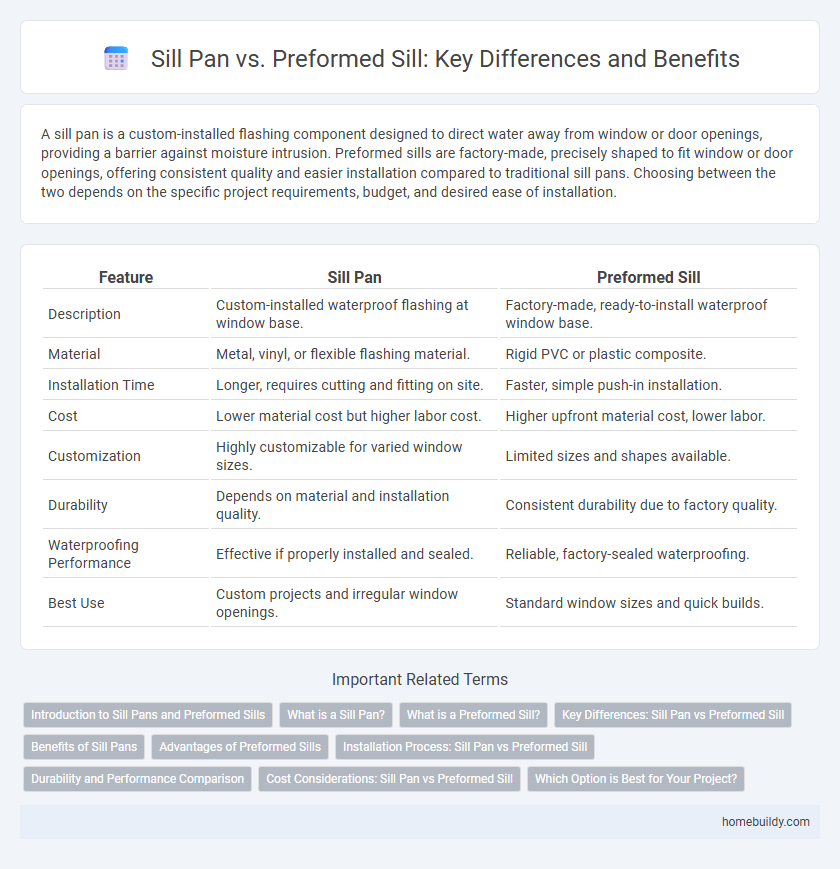A sill pan is a custom-installed flashing component designed to direct water away from window or door openings, providing a barrier against moisture intrusion. Preformed sills are factory-made, precisely shaped to fit window or door openings, offering consistent quality and easier installation compared to traditional sill pans. Choosing between the two depends on the specific project requirements, budget, and desired ease of installation.
Table of Comparison
| Feature | Sill Pan | Preformed Sill |
|---|---|---|
| Description | Custom-installed waterproof flashing at window base. | Factory-made, ready-to-install waterproof window base. |
| Material | Metal, vinyl, or flexible flashing material. | Rigid PVC or plastic composite. |
| Installation Time | Longer, requires cutting and fitting on site. | Faster, simple push-in installation. |
| Cost | Lower material cost but higher labor cost. | Higher upfront material cost, lower labor. |
| Customization | Highly customizable for varied window sizes. | Limited sizes and shapes available. |
| Durability | Depends on material and installation quality. | Consistent durability due to factory quality. |
| Waterproofing Performance | Effective if properly installed and sealed. | Reliable, factory-sealed waterproofing. |
| Best Use | Custom projects and irregular window openings. | Standard window sizes and quick builds. |
Introduction to Sill Pans and Preformed Sills
Sill pans provide a customizable waterproof barrier at window and door openings, typically fabricated on-site using materials like aluminum or PVC to ensure precise fitting and effective drainage. Preformed sills are factory-made units designed for quick installation, offering consistent quality and built-in slopes to direct water away efficiently. Both serve as critical components in moisture management, but the choice hinges on project-specific needs for flexibility versus convenience and uniformity.
What is a Sill Pan?
A sill pan is a waterproof barrier installed at the base of window or door openings to prevent water infiltration and protect the building structure. Unlike preformed sills made from rigid materials, sill pans are often custom-fabricated on-site from flexible flashing materials to ensure a precise fit and enhanced drainage capability. Proper installation of a sill pan directs water drainage away from the wall assembly, reducing the risk of moisture damage and mold growth.
What is a Preformed Sill?
A preformed sill is a factory-made, molded drainage system designed to fit beneath exterior door frames, providing superior water management compared to traditional sill pans. Unlike custom-built sill pans, preformed sills are constructed from durable materials like PVC or composite, ensuring consistent dimensions and enhanced resistance to moisture infiltration. This results in faster installation, improved waterproofing performance, and reduced risk of water damage around door thresholds.
Key Differences: Sill Pan vs Preformed Sill
Sill pans are custom-fabricated, typically made from metal or plastic, designed to be installed on-site for precise fitting, while preformed sills come as ready-made units that simplify installation but may require adjustments for variations in window dimensions. Sill pans offer superior flexibility and can be tailored to complex openings, enhancing water management by directing drainage away from the window assembly. Preformed sills provide consistent quality and uniform thickness, reducing installation errors but might lack the adaptability of sill pans in irregular or non-standard window applications.
Benefits of Sill Pans
Sill pans provide superior water drainage and protection against moisture intrusion compared to preformed sills, reducing the risk of mold and structural damage. Customizable on-site, sill pans ensure a precise fit for unique window openings, enhancing overall energy efficiency and sealing. Their durable materials, often flexible and corrosion-resistant, extend the lifespan of window installations while simplifying maintenance.
Advantages of Preformed Sills
Preformed sills offer superior durability and consistent dimensions compared to sill pans, reducing installation time and minimizing the risk of water infiltration. They are fabricated from high-quality materials with integrated sloping, ensuring exceptional drainage and long-term resistance to moisture damage. This precision manufacturing enhances overall window performance by providing a reliable, watertight seal that prevents costly repairs.
Installation Process: Sill Pan vs Preformed Sill
Installing a sill pan typically involves customizing a metal or plastic flashing on-site to fit the rough opening, requiring precise measuring, cutting, and sealing to ensure water tightness. Preformed sills come factory-made to standard dimensions, offering quicker installation with less on-site modification, reducing the risk of errors and improving consistency in water protection. Both methods require proper integration with window units and surrounding flashing systems to prevent moisture intrusion effectively.
Durability and Performance Comparison
Sill pans, typically custom-fabricated from metal or flexible flashing materials, offer superior durability by providing a precise fit that prevents water infiltration and resists rust and corrosion over time. Preformed sills, made from rigid plastic or vinyl, deliver consistent performance with easy installation but may become brittle or crack under extreme weather conditions, reducing their long-term effectiveness. The custom adaptability of sill pans generally results in enhanced water-resistant performance and a longer lifespan compared to preformed sill alternatives.
Cost Considerations: Sill Pan vs Preformed Sill
Sill pans are typically more cost-effective due to their customizable nature and use of standard materials, whereas preformed sills come with a higher upfront price but reduce labor costs due to quicker installation. The choice impacts the overall project budget depending on the balance between material cost savings and labor efficiency. Evaluating the total cost requires considering site-specific factors like window size, installation complexity, and durability requirements.
Which Option is Best for Your Project?
Sill pans are custom-fitted, offering flexibility for unique window openings and ensuring precise water drainage, while preformed sills provide quick installation with uniform shape and material consistency. Choosing between a sill pan and a preformed sill depends on project specifics such as budget, site conditions, and desired durability, with custom pans favored for complex designs and preformed sills preferred for standard applications. Evaluating factors like waterproofing effectiveness, labor costs, and material compatibility will help determine the best option for your construction needs.
sill pan vs preformed sill Infographic

 homebuildy.com
homebuildy.com